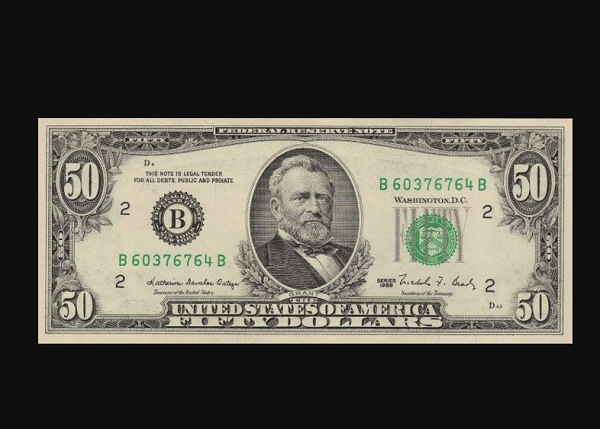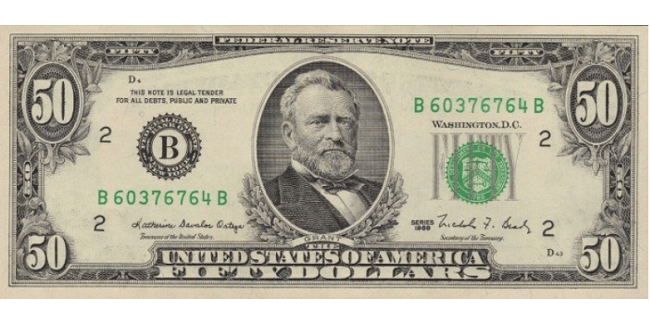1988 50 Dollar Bill Value – $50 may not seem like a significant amount now, but what if we told you that your 1988 50-dollar bill could be worth much more than its face value?
In this blog post, we will discuss the history and potential value of the 1988 50-dollar bill, so keep reading to find out if your bill could be worth a small fortune today.
Most 1988 fifty-dollar bills aren’t considered particularly valuable. However, there is an exception – star notes. Star notes are replacement bills that the United States Federal Reserve printed, and they tend to be more rare and therefore more valuable.
Keep reading to learn more about the specifications, grading system, and identifying errors in 1988 $50 bills, and find out if your bill could be worth more than you think.

1988 50 Dollar Bill Specifications
Curious about the specifications of the 1988 50 dollar bill, look no further! This bill has a denomination of $50.00 USD and is classified as a Federal Reserve Note.
The signature combinations for this particular bill are Ortega and Brady. Additionally, it falls under Series One of the 1988 bills.
It’s interesting to note that the 1988 50 dollar bill specifications are slightly different from the current bills in circulation.
For example, the 1990 series onwards has a security strip to the left of the Grant portrait, which glows under UV light. However, the 1988 series and any prior series do not have this security strip.

1988 50 Dollar Bill Value
The value of a 1988 50 dollar bill, it’s important to consider its condition and any unique features. In circulated condition, these bills are generally only worth their face value of $50. However, if you happen to have a bill in uncirculated condition, it can sell for a premium.
Most 1988 series $50 bills in uncirculated condition with a grade of MS 63 are worth around $100-125.
But there’s a chance you could find a bill issued from the Federal Reserve Bank of Kansas City, which can fetch a slightly higher price of around $175 in the same condition and grade.
However, the real potential for value lies in star notes.
These are replacement bills printed by the United States Federal Reserve and are rare and therefore more valuable.
Most 1988 fifty dollar bills may not hold much value, there’s always a chance you could be sitting on a small fortune.
1988 50 Dollar Bill Star Notes
Star notes are a fascinating aspect of the 1988 50 dollar bill.
These replacement bills were printed by the United States Federal Reserve and are considered more rare and valuable than standard bills.
So how can you identify if you have a star note?
Simply look at the end of the serial number on your 1988 fifty dollar bill and see if there is a star symbol.
It’s incredible to think that a simple star symbol can significantly increase the value of your 1988 fifty dollar bill.
1988 50 Dollar Bill Grading System
To grade a 1988 50 dollar bill, one important classification is MS 63 choice uncirculated. This designation signifies a note that has never been circulated and shows no signs of wear or tear.
In other words, it is in pristine condition with its original crispness intact.
Additionally, a bill with an MS 63 grade is also well-centered, meaning that the design elements are aligned properly.
Most 1988 fifty dollar bills aren’t considered particularly valuable, an MS 63 choice uncirculated bill can sell for around $100-125 in uncirculated condition.
Keep in mind that bills issued from the Federal Reserve Bank of Kansas City can fetch a slightly higher price of around $175 in the same condition and grade.
You never know what hidden treasures you may find, including the possibility of an 1985 $50 dollar bill.
Identifying Error in 1988 $50 Dollar Bills
To identify errors in 1988 $50 dollar bills, there are a few things to look out for. One common error is a misprinted or mismatched serial number. This means that the serial number on the bill does not match the expected pattern for a 1988 series bill.
Another error to be aware of is misaligned printing. This occurs when the design elements on the front and back of the bill are not properly aligned.
This can sometimes result in parts of the bill being cut off or appearing distorted.
Keep an eye out for any unusual or unique markings on the bill. These could be printing errors or even counterfeit indicators.
Be on the lookout for any bills that may have been altered or tampered with. This could include bills that have been washed, bleached, or reprinted with different denominations.
Remember, if you do come across any errors or unique markings on your 1988 $50 dollar bill, it could potentially increase its value, so don’t dismiss them as insignificant.
Does a 1988 $50 dollar bill have a security strip?
Yes, $50 bills from the 1990 series onwards have a plastic strip to the left of the Grant portrait which glows under UV light. This security strip was implemented as a measure to prevent counterfeiting and to make it easier to verify the authenticity of the bill.
However, if you have a 1988 $50 dollar bill, it does not have this security strip.
It’s interesting to note the changes in security features over the years, as newer bills often incorporate more advanced technologies to stay ahead of counterfeiters.
The absence of a security strip on the 1988 $50 bill is not necessarily a sign of a counterfeit bill, as it simply reflects the design of bills from that time period.
So, if you’re examining a 1988 $50 dollar bill and don’t see a security strip, don’t worry. It’s just a characteristic of bills from that particular series.
Conclusion
Most 1988 fifty dollar bills may not hold much value, there is always the possibility that you could be sitting on a small fortune. The standard bills in circulated condition are only worth their face value of $50.
However, if you happen to have a bill in uncirculated condition, it can sell for a premium.
Most 1988 series $50 bills in uncirculated condition with a grade of MS 63 are worth around $100-125. But the real excitement lies in star notes.
These replacement bills printed by the United States Federal Reserve are rare and therefore more valuable.
Remember, keep an eye out for the rare 1985 $50 dollar bill as well, as it has its own set of unique and valuable features. Happy hunting!